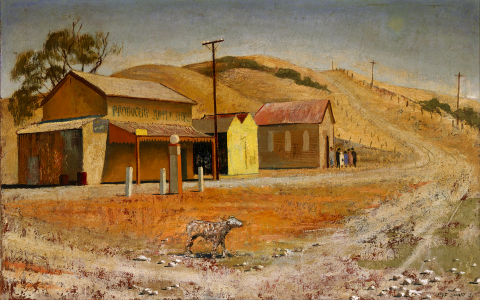PARINGA, 1951
JEFFREY SMART
oil on canvas
51.5 x 81.5 cm
signed and dated lower right: JEFF SMART 51
David Jones Art Gallery, Sydney
Private collection
Christie’s, Sydney, 1 October 1974, lot 124
Private collection, Sydney
Sotheby’s, Sydney, 22 October 1986, lot 115
Holdsworth Galleries, Sydney
Private collection, Sydney
Dunlop Art Prize, Tye’s Art Gallery, Melbourne, 4 May 1951
Jeff Smart, Jacqueline Hick, David Jones Art Gallery, Sydney, 12 – 19 September 1952, cat. 1
Jeffrey Smart Retrospective Exhibition, Art Gallery of New South Wales, Sydney, 27 August – 31 October 1999, cat. 11, then travelling to: Art Gallery South Australia, Adelaide, 26 November 1999 – 6 February 2000; Queensland Art Gallery, Brisbane, 10 March – 21 May 2000; Museum of Modern Art at Heide, Bulleen, 10 June – 6 August 2000 (label attached verso)
Master of Stillness, Jeffrey Smart paintings 1940 – 2011, Samstag Museum of Art, University of South Australia, Adelaide, 12 October – 14 December 2012 and touring to TarraWarra Museum of Art, Victoria, 21 December 2012 – 1 April 2013
Quartermaine, P., Jeffrey Smart, Gryphon Books, Melbourne, 1983, pp. 14, 104, cat. 222 (illus. p. 14)
Capon, E., Jeffrey Smart Retrospective, Art Gallery of New South Wales, Sydney, 1999, p. 76, 204, cat. 11 (illus. p. 76)
Pearce, B., Master of Stillness, Jeffrey Smart, Wakefield Press, Adelaide, revised edition, 2015, pp. 48, 49 (illus.)
Paringa, 1951 is one of those rare, early Jeffrey Smart paintings which, South Australian in subject, still remains in private hands. A companion, Wallaroo, 1951, is in the collection of the National Gallery of Australia, Canberra, and others are well represented in state and national galleries. Keswick Siding, 1945 and Kapunda Mines, 1946, for example, are in the collections of the Art Gallery of New South Wales and the National Gallery of Victoria, Melbourne, while several more in the Art Gallery of South Australia include Robe 1947. Wallaroo won the Commonwealth Jubilee Prize in 1951 before joining Paringa in Smart’s joint exhibition with fellow South Australian, Jacqueline Hick, at David Jones’ Gallery, Sydney in September 1952. A critic for The Sydney Morning Herald introduced his review with the observation that they ‘are painters who believe in organisation, a careful planning of all those shapes which could be called the stageprops [sic.] of their paintings’. He added that their work was ‘promising and ambitious’. 1
Although today the small town of Paringa in the South Australian Riverland is well known for its vineyards and orchards, Smart presents a remote, sun-baked vision of dryness, featuring a few timber buildings of settlement connected to the distant world by dusty road and telegraph line. The rocks and textured foreground bear witness to its dryness, which if emphasised by the isolated lamb, blended so effectively into the scene. Even the leaves on trees and bushes look brown, in harmony with the colours of the buildings. All are shut in keeping with the stillness, except the church where people stand outside after the service. For the youthful Smart, the landscape is a very considered still life, full of the Surrealist suggestion and isolation so celebrated in his later works. Here, the lamb provides focus and scale – the role adopted by the human figure elsewhere in future paintings. This use of the solitary image emerged early in Smart’s compositions, as seen so effectively in the pram prominent in the foreground of Holiday Resort, 1946 in the Art Gallery of South Australia.
Paringa, 1951, in addition to its own delights of colour and composition, offers many more tantalising harbingers of things to come – above all, the road as it sweeps up the hill. Now dusty, the dirt and stone would later to be replaced by the engineering marvels of the Italian autostrade and mighty German autobahn. Although there are no road signs, a petrol pump suffices, indicating already the artist’s fascination with form and its exploitation as metaphors of the modern world of vehicles and transportation.
While people leaving of church in the middle background may seem a minor incident, it provides a biographical touch, as featured in Sunday Morning Service, 1945 (private collection). Given Smart was born and bred in Adelaide, the ‘City of Churches’, such references are understandable. As ever, the emptiness that typifies so much of Smart’s painting is, paradoxically, full of incident.
1. ‘Exhibition By Two Artists’, Sydney Morning Herald, Sydney, 12 September 1952, p. 2
DAVID THOMAS
